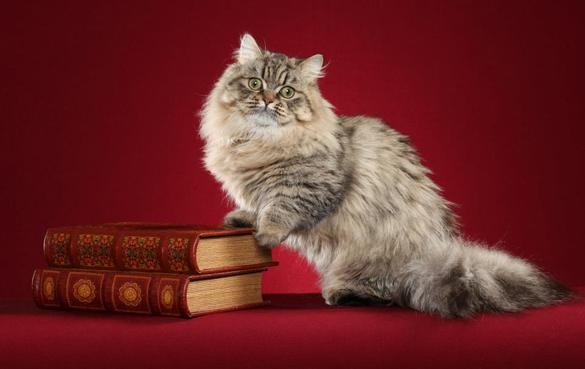General Description and History
The striking look of the Highlander cats with its long sloping profile and loosely curled ears draws attention to this substantial cat. But it is the fun-loving nature that steals hearts as it entertains you with its crazy antics. This is a cat that loves to be the center of attention and its big cat look also helps keep it front and center. The Highlander cat comes in both short and long hair.
Development of the breed began in 2004 with the intent of creating a domestic cat with a powerful “big cat” look. In 2005, the name Highlander was settled on and highlander cat breeders focused on defining the breed and its characteristics as they worked toward championship status in TICA – one of the largest registries in the world. The cats used to develop the breed were carefully chosen from the domestic gene pool and not from any existing recognized breed. The ears are a key feature of the Highlander. TICA recognized the Highlander for competition in the Preliminary New Breed class starting May 1st, 2008.
Highlander Cat Personality
Despite their “big cat” look, the Highlander cats are the clowns of the cat fancy and love to play and chase. They love human company and will be there to greet you at the door or will show off to visitors. Vocally they are relatively quiet cats but physically they are high energy cats. This energy comes out in entertaining chase games and it is this energetic activity that helps build the powerful musculature that is so characteristic of this breed.
Traits
The Highlander cat has a long, sloping forehead and medium to large eyes shaped like a slightly flattened oval set on a bias that look at you with great intensity. The nose is wide with large nose leather. Together, the nose, muzzle and chin provide a boxy look to the muzzle. The chin itself is deep and strong. These features make the head appear longer than it is wide. The ears are unique: the top 1/3 has a loose curl. They are set as much on the top of the head as on the side and stand tall and open with good width at the base.
The powerful, muscular body is substantial and entrances you with the beauty of its movement. Flexible long hind legs combine with the rippling muscles developed in the torso from its active play. The feet are large and have prominent knuckles. These are big powerful looking cats with a gentle disposition. The naturally short tail ranges in length from 1 inches to hock length. It is thick and articulated, and sometimes has kinks and curls in it. It also has a fat pad at the end. The Highlander cat’s tail is an incredibly expressive element of the breed and will wag like a dog from sheer joy and signal its happiness and playfulness.
Highlander Cat Care
Highlander cats can be both short haired and long haired and the name refers to the intent of creating a domestic cat with a powerful “big cat”. It has curled tufted ears, a short bobbed tail and often polydactyl feet.
Health and welfare of cats with folded or curled ears
There are several breeds of cat with ears that do not stand up in the normal way – some folding downwards and some curling backwards. The most well known is the Scottish Fold cat where the Scottish Fold gene mutation detrimentally affects cartilage, most obviously seen making the ear cartilage fold. However, the cartilage defect affects their joints as well as the ear cartilage and folds can suffer from severe and painful degenerative joint disease throughout their lives. As the disease progresses the joints stiffen, bones fuse and movement becomes more difficult and extremely painful. Folded or curled ears can also make it difficult for the cat to clean its ears, so owners may need to remove any wax or dirt accumulation from the ear to help prevent discomfort and infection.
We do not have enough information to know whether gene mutations resulting in curled (rather than the folded) ears causes similar problems in cartilage at other sites (such as joints), but there are comments from highlander cat breeders that the ears are fragile and may be easily damaged when handled and there is anecdotal mention of narrowed ear canals.
Health and welfare of cats with shortened tails
There is always a strong worry the lack of, or shortened, tail is caused by an inherited deformity of the end of the spine – similar to the Manx cat. There are various different breeds with short tails (stumpy tails), which may be caused by different genetic mutations. The Manx cat’s lack of tail is the result of a genetic mutation that causes severe disease. The true (or ‘rumpy’) Manx has only a small hollow where the tail would have been, although cats with residual (stumpy) tails are also born. The defective gene responsible for the loss of the tail also affects other parts of the spine and may cause severe spinal and/or neurological problems. When two completely tailless Manx cats are mated, the defects may be so severe that many of the offspring may be born dead or die shortly after birth.
The same problems occurs in at least some other breeds with short tails, although often there is not a great deal of information on these other breeds. However, with a potential risk of more severe problems, and the lack of a normal tail raises serious questions as to whether breeds should exist which rely on such deformities. Even without further problems, it should be questioned whether deliberately breeding cats without a normal tail is justified and could ever be in the cat’s interest.













